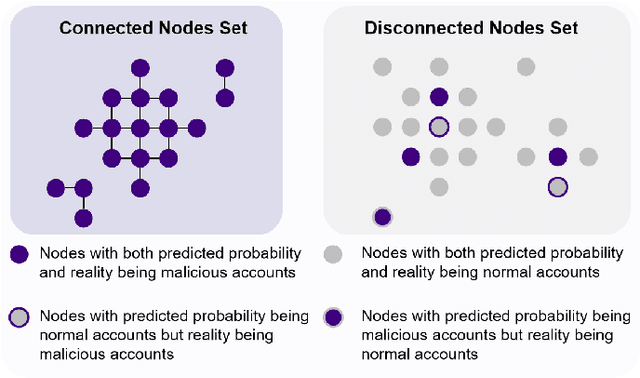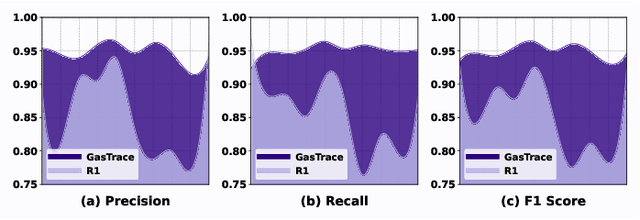Hongli Peng
A Comprehensive Study of Exploitable Patterns in Smart Contracts: From Vulnerability to Defense
Apr 30, 2025Abstract:With the rapid advancement of blockchain technology, smart contracts have enabled the implementation of increasingly complex functionalities. However, ensuring the security of smart contracts remains a persistent challenge across the stages of development, compilation, and execution. Vulnerabilities within smart contracts not only undermine the security of individual applications but also pose significant risks to the broader blockchain ecosystem, as demonstrated by the growing frequency of attacks since 2016, resulting in substantial financial losses. This paper provides a comprehensive analysis of key security risks in Ethereum smart contracts, specifically those written in Solidity and executed on the Ethereum Virtual Machine (EVM). We focus on two prevalent and critical vulnerability types (reentrancy and integer overflow) by examining their underlying mechanisms, replicating attack scenarios, and assessing effective countermeasures.
Mining Characteristics of Vulnerable Smart Contracts Across Lifecycle Stages
Apr 21, 2025



Abstract:Smart contracts are the cornerstone of decentralized applications and financial protocols, which extend the application of digital currency transactions. The applications and financial protocols introduce significant security challenges, resulting in substantial economic losses. Existing solutions predominantly focus on code vulnerabilities within smart contracts, accounting for only 50% of security incidents. Therefore, a more comprehensive study of security issues related to smart contracts is imperative. The existing empirical research realizes the static analysis of smart contracts from the perspective of the lifecycle and gives the corresponding measures for each stage. However, they lack the characteristic analysis of vulnerabilities in each stage and the distinction between the vulnerabilities. In this paper, we present the first empirical study on the security of smart contracts throughout their lifecycle, including deployment and execution, upgrade, and destruction stages. It delves into the security issues at each stage and provides at least seven feature descriptions. Finally, utilizing these seven features, five machine-learning classification models are used to identify vulnerabilities at different stages. The classification results reveal that vulnerable contracts exhibit distinct transaction features and ego network properties at various stages.
GasTrace: Detecting Sandwich Attack Malicious Accounts in Ethereum
May 30, 2024


Abstract:The openness and transparency of Ethereum transaction data make it easy to be exploited by any entities, executing malicious attacks. The sandwich attack manipulates the Automated Market Maker (AMM) mechanism, profiting from manipulating the market price through front or after-running transactions. To identify and prevent sandwich attacks, we propose a cascade classification framework GasTrace. GasTrace analyzes various transaction features to detect malicious accounts, notably through the analysis and modeling of Gas features. In the initial classification, we utilize the Support Vector Machine (SVM) with the Radial Basis Function (RBF) kernel to generate the predicted probabilities of accounts, further constructing a detailed transaction network. Subsequently, the behavior features are captured by the Graph Attention Network (GAT) technique in the second classification. Through cascade classification, GasTrace can analyze and classify the sandwich attacks. Our experimental results demonstrate that GasTrace achieves a remarkable detection and generation capability, performing an accuracy of 96.73\% and an F1 score of 95.71\% for identifying sandwich attack accounts.
A Point Cloud Enhancement Method for 4D mmWave Radar Imagery
Jan 30, 2024Abstract:A point cloud enhancement method for 4D mmWave radar imagery is proposed in this paper. Based on the patch antenna and MIMO array theories, the MIMO array with small redundancy and high SNR is designed to provide the probability of high angular resolution and detection rate. The antenna array is deployed using a ladder shape in vertical direction to decrease the redundancy and improve the resolution in horizontal direction with the constrains of physical factors. Considering the complicated environment of the real world with non-uniform distributed clutters, the dynamic detection method is used to solve the weak target sensing problem. The window size of CFAR detector is assumed variant to be determined using optimization method, making it adaptive to different environments especially when weak targets exist. The angular resolution increase using FT-based DOA method and the designed antenna array is described, which provides the basis of accurate detection and dense point cloud. To verify the performance of the proposed method, experiments of simulations and practical measurements are carried out, whose results show that the accuracy and the point cloud density are improved with comparison of the original manufacturer mmWave radar of TI AWR2243.
An Overview of AI and Blockchain Integration for Privacy-Preserving
May 06, 2023Abstract:With the widespread attention and application of artificial intelligence (AI) and blockchain technologies, privacy protection techniques arising from their integration are of notable significance. In addition to protecting privacy of individuals, these techniques also guarantee security and dependability of data. This paper initially presents an overview of AI and blockchain, summarizing their combination along with derived privacy protection technologies. It then explores specific application scenarios in data encryption, de-identification, multi-tier distributed ledgers, and k-anonymity methods. Moreover, the paper evaluates five critical aspects of AI-blockchain-integration privacy protection systems, including authorization management, access control, data protection, network security, and scalability. Furthermore, it analyzes the deficiencies and their actual cause, offering corresponding suggestions. This research also classifies and summarizes privacy protection techniques based on AI-blockchain application scenarios and technical schemes. In conclusion, this paper outlines the future directions of privacy protection technologies emerging from AI and blockchain integration, including enhancing efficiency and security to achieve a more comprehensive privacy protection of privacy.
 Add to Chrome
Add to Chrome Add to Firefox
Add to Firefox Add to Edge
Add to Edge